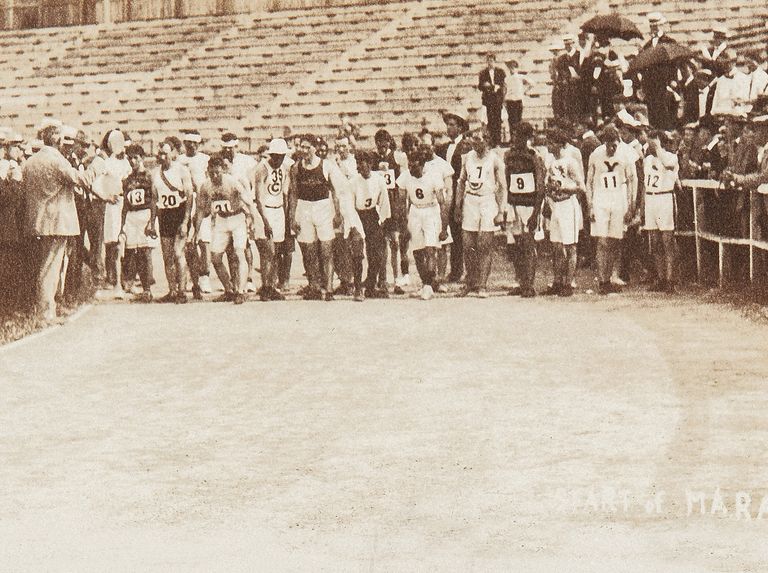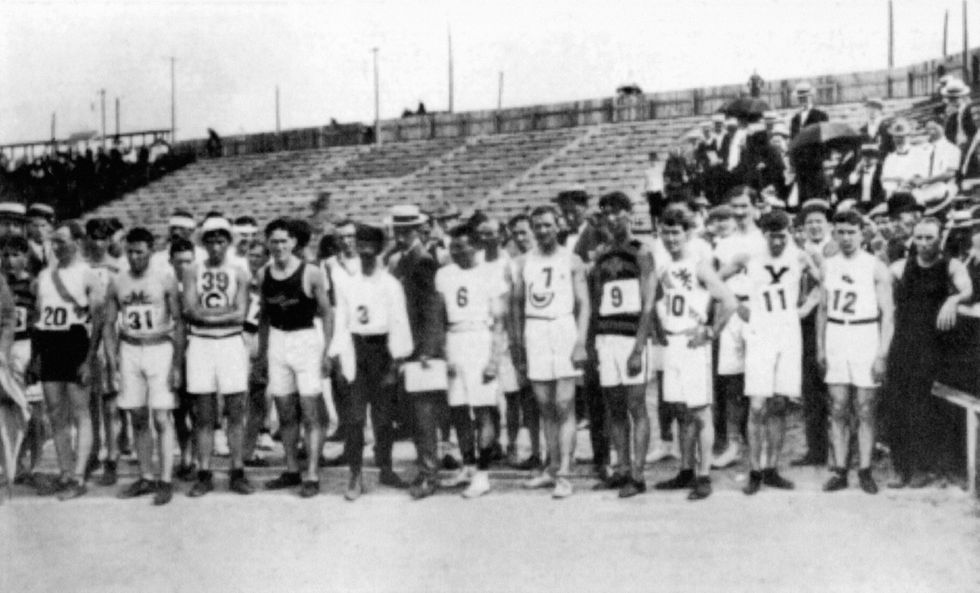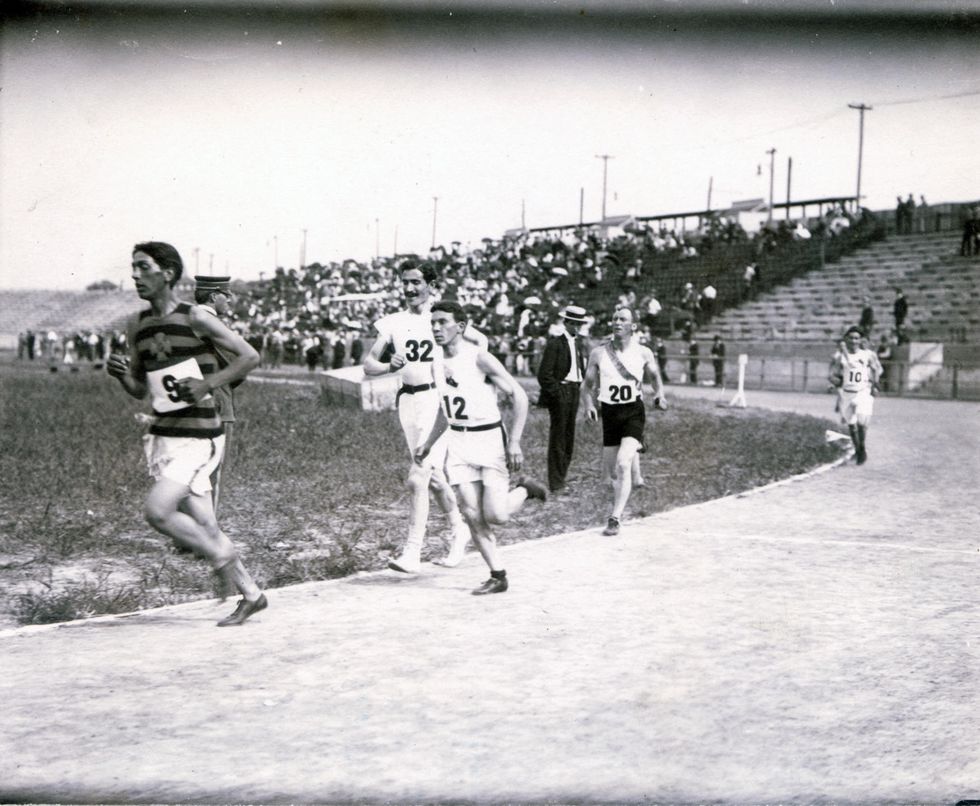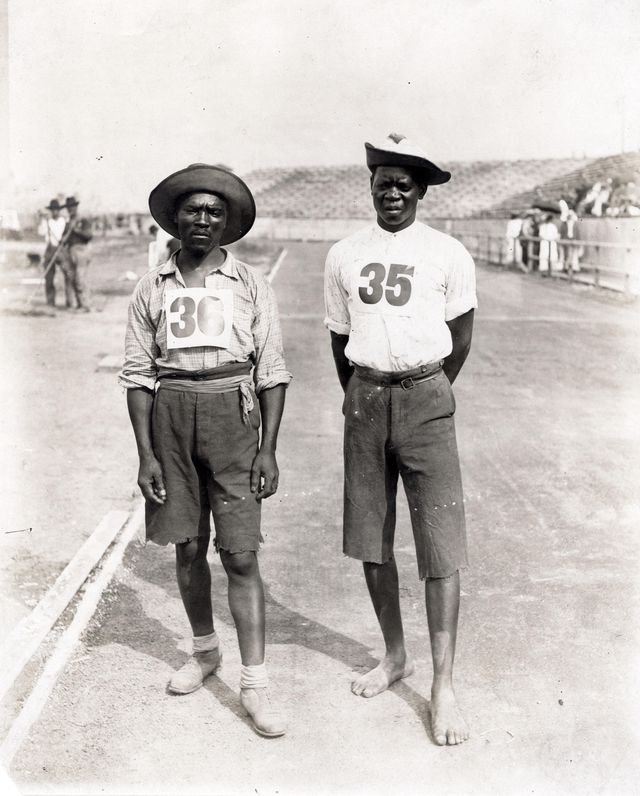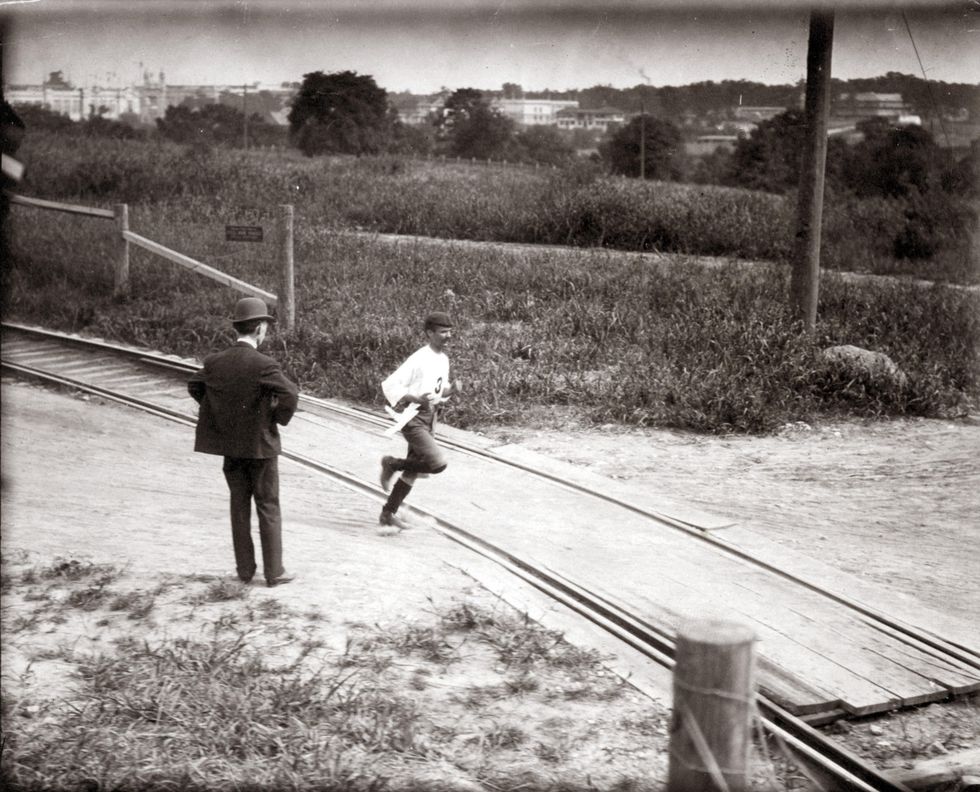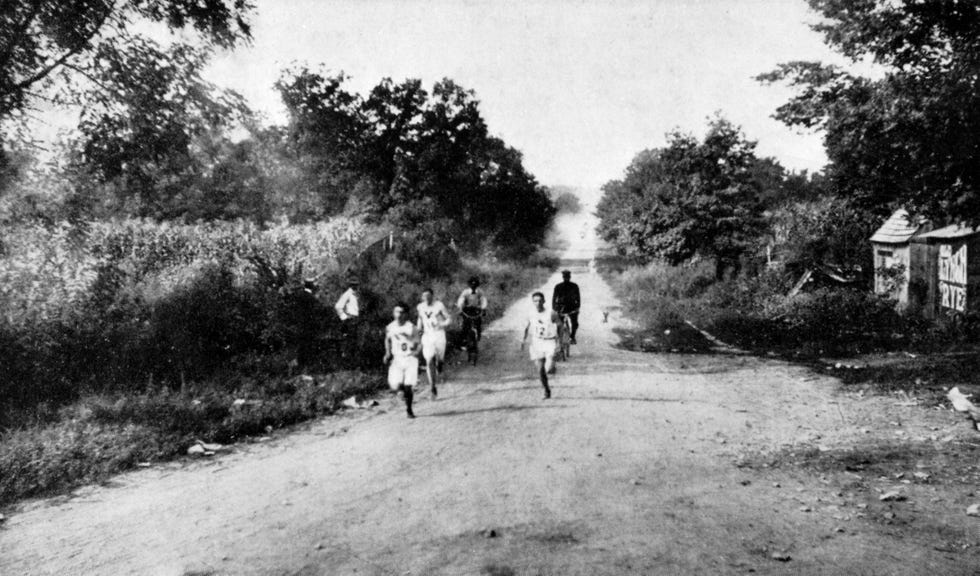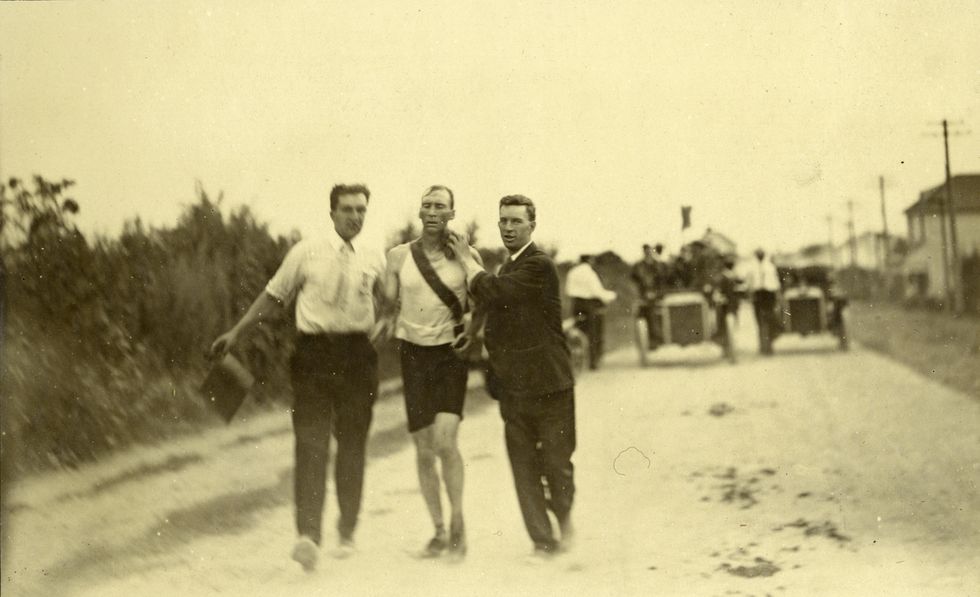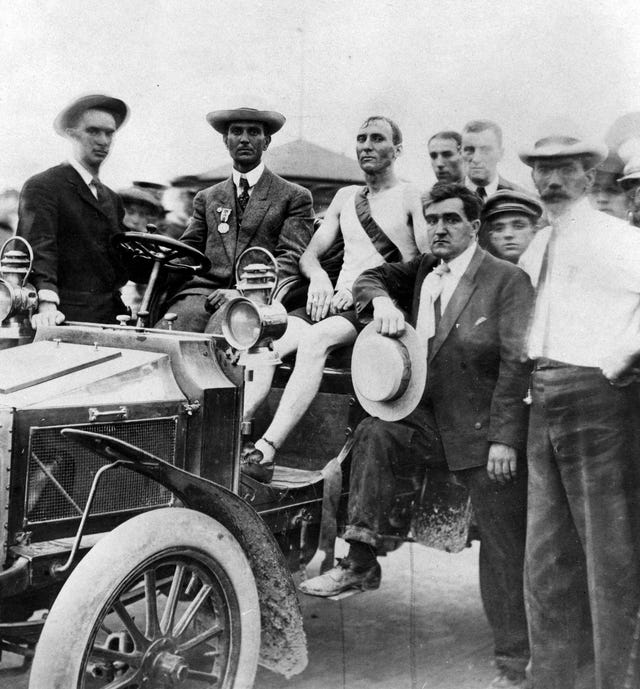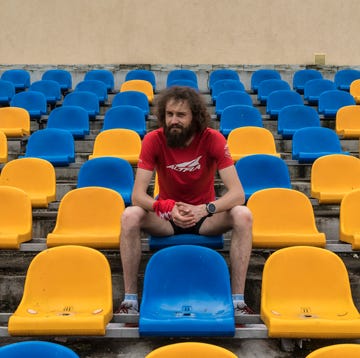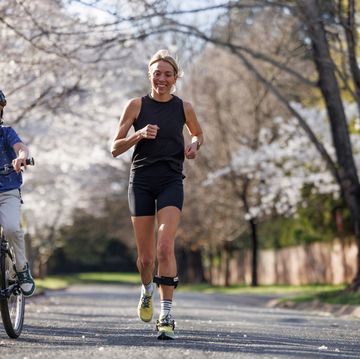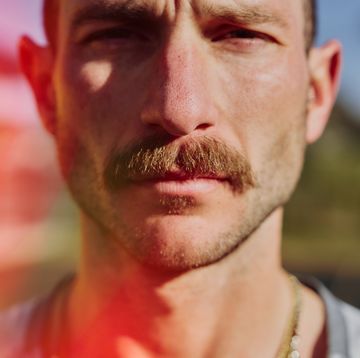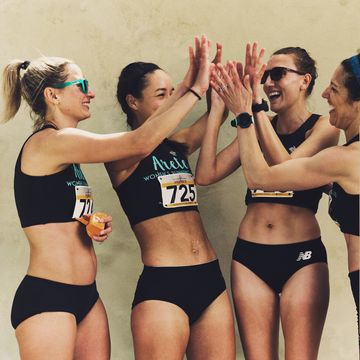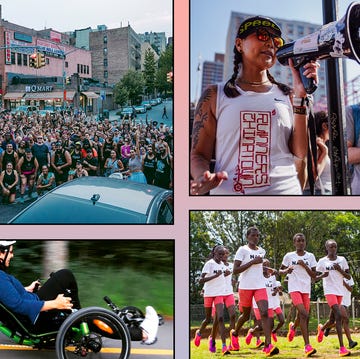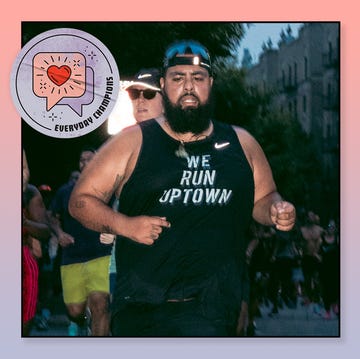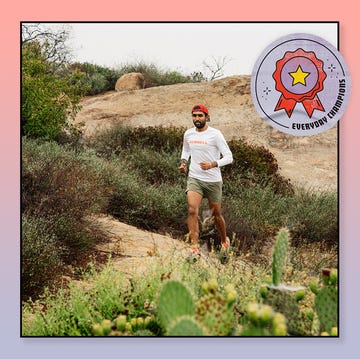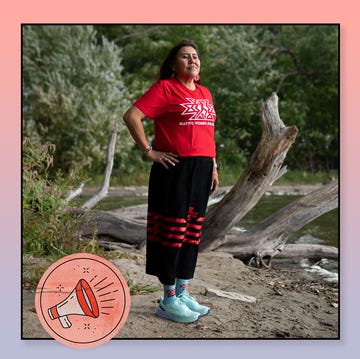On a broiling, 90-degree August afternoon in 1904, 32 men dressed largely in white with leather belts gathered at Francis Olympic Field, a newly constructed stadium in St. Louis. Flanked by other men in suits and porkpie hats, they were about to compete in what would become the most infamous marathon in history. The event was part of the Louisiana Purchase Exposition, also known as the 1904 World’s Fair. Within the crowd of dapper onlookers was the man in whose honor the stadium was named: David R. Francis, a former Missouri governor and president of the organizing committee for the Olympic Games. At 3:03 p.m. he fired the starting gun; so began the first Olympic marathon race on U.S. soil.
The race started with five laps around the track and a flurry of lead changes. Among the cast of largely American runners were three previous Boston Marathon winners. None of them would finish. In fact, only 14 men eventually completed the race: one after hitchhiking, one after taking a nap, and one—the eventual gold medalist—after drinking strychnine mixed with raw egg and brandy. Not only would the percentage of finishers rank as the lowest of any Olympic marathon, but the event itself would be marred by the racism that pervaded and even guided the 1904 Olympics and World’s Fair.
Frank Pierce from the Seneca Nation—the first Native American to compete in the Olympics—briefly took to the front. Pierce was followed closely by fellow Americans Arthur Newton, Thomas Hicks, and Sam Mellor.
As the men made the third lap, another American, Fred Lorz, took a turn in the lead. Lorz, a bricklayer by trade, had the muscular build of a sprinter but had finished in the top five at the previous two Boston Marathons. Close behind, the race claimed its first casualty: The 1903 Boston champ, John Lordan, Irish-born but running for the United States, began vomiting and walked off the track to register the first DNF.
Hicks, who’d finished second behind Lordan at Boston that previous year, passed Lorz to lead racers out of the stadium. Hicks purportedly made his living as a professional clown. Yet in the few surviving pictures of the race, Hicks appears to be the most serious man in St. Louis, standing uncomfortably straight at the start line with a near scowl.
Striding onto the dirt roads beyond Francis Field, the runners were greeted by red flags marking the route. The man responsible for those flags, along with much of the 1904 St. Louis Olympics, was James E. Sullivan, head of the Physical Culture Department for the World’s Fair. Sullivan intended to use the Games to showcase white American excellence through a series of events that ranged from the poorly executed, like the marathon, to the cartoonishly racist, like the fair’s Anthropology Days—a two-day Olympic-style competition during which nonwhite performers from the fair’s living anthropology displays competed in sports they’d never played before. The idea was to flaunt their athletic inferiority to the world. A headline in the St. Louis Post-Dispatch, “Barbarians meet in Athletic Games,” made no bones about that intention.
Sullivan also designed the 24.85-mile race (26.2 became the standard in 1921) as an experiment to test his own exercise science theories. Chief among his beliefs was that of “purposeful dehydration.” Following the conventional wisdom of the time, Sullivan insisted that drinking (or eating) during exercise would only upset the stomach. Accordingly, there was only one water station on the course, near mile 12.
Three miles in, Newton, who’d won bronze just a day before in the steeplechase, held fifth, the same as his finishing position at the 1900 Olympic marathon. Hicks, the professional clown, fell back to seventh. And Albert Corey, a French-born, U.S.-representing marathoner who lived in Chicago and worked at a slaughterhouse, ran in ninth place.
Trailing close behind were Len Taunyane and Jan Mashiani, both running their first marathon. The two members of South Africa’s Tswana tribe were the first Black Africans to compete in the Olympics. In fact, they were the only Black athletes to represent that nation until the end of apartheid 86 years later. Taunyane and Mashiani had no formal racing experience and were in St. Louis performing in the World’s Fair’s Boer War Exhibition. Taunyane and Mashiani had been message runners for the Boers and were part of a cast of hundreds that twice a day reenacted battles from the recent Second Boer War, between Dutch colonist Boers and the British Empire, in front of thousands of spectators.
Leading the way out of the stadium was a vanguard of horsemen, riding ahead of the racers to clear the dry dirt roads. Right behind them, a motorcade of journalists, doctors, support teams, and race officials followed, producing a steady brown cloud that enveloped the runners for most of the course.
At six miles Newton led, with 1902 Boston champ Sam Mellor in pursuit on the dusty road. Behind them were Lorz and Félix Carvajal, a Cuban mailman who’d arrived at the race in a long-sleeve shirt, hat, pants, heavy shoes, and a notable mustache. (A helpful Samaritan assisted Carvajal in cutting his pants into shorts prior to the start of the race.) Carvajal had raised the money for his journey to America by running exhibitions in his native Cuba, but after gambling away his funds on a layover in New Orleans, he’d hitchhiked the rest of the way to St. Louis. Carvajal was among the favorites to win; however, he was also a loquacious man, frequently stopping for mid-competition banter with spectators.
Approaching the 10-mile marker, Fred Lorz, plagued by muscle cramps, flagged down a car (likely that of his coach) for a ride back to Francis Field. Carvajal also stopped, but to find a snack. According to some accounts, Carvajal ate rotten apples from an orchard along the road. One writer observed Carvajal playfully swiping peaches from spectators after they’d denied his request for fruit. Either way, Carvajal suffered from stomach cramps and lay down to take a short nap.
At mile 12, the racers encountered the well that served as the lone water station. Sullivan had intended to test purposeful dehydration in the race by observing how athletes would perform in high-intensity work, on a hot summer day, with a limited amount of water available to drink.
Undeterred by the fact that fewer than half of his marathoners finished, he’d later write a book, 1909’s Marathon Running, which reiterated his continued belief in the power of water abstinence. “Don’t get into the habit of drinking and eating in a marathon race; some prominent runners do, but it is not beneficial,” he wrote.
Halfway through the marathon, Mellor was leading, with Newton and Hicks, respectively, in second and third place. Mellor had been the pre-race favorite. In addition to his Boston win, he’d podiumed there in 1901 and 1903, and he’d won the Pan American Exposition marathon in 1901, in 104-degree heat. But this time, Mellor’s pace slowed by mile 16 to combat cramping. By another account, he incorrectly believed he’d taken a wrong turn and tired himself out running backward on the course. In any case, he soon dropped out of the race. Hicks took the lead, with Newton trailing.
Hicks, now beyond the water station, began to grow desperately thirsty. He had two trainers following in a car, and he began to beg them for a drink of water. They refused, and instead gave his mouth and shoulders a sponge bath in an attempt to relieve the thirst without hydrating their athlete.
Near mile 19, William Garcia, a racer out of San Francisco who was in fourth place at the time, collapsed. He likely experienced the closest brush with death of any marathoner that day. On the side of the road, he began coughing up blood and passed out before being discovered and taken to a hospital. The combination of heat, dehydration, and roughly two hours of running through dust clouds landed Garcia in surgery for a dust-lined esophagus and a torn stomach lining.
Lorz, meanwhile, was feeling refreshed after riding in a car for 11 miles after his cramping episode. He decided to continue the last miles on foot, into the stadium, and across the finish line to claim victory in under three hours. Just as First Daughter Alice Roosevelt Longworth was crowning Lorz as the victor, a spectator revealed that Lorz had been driven along the course. Lorz defended his victory as merely a joke, but the stunt earned him a lifetime ban.
As Lorz was explaining himself away, Hicks held the lead with roughly four miles remaining, but he continued to suffer from dehydration. His trainers, making history, decided to give him something stronger than a damp sponge. In the first recorded instance of performance-enhancing drug use in the Olympics, Hicks was fed a combination of egg whites and 1 milligram of strychnine sulfate. In high doses, this compound is used as rat poison. At lower doses, however, it is a stimulant and currently prohibited for in-competition use by the World Anti-Doping Agency.
A ghastly Hicks continued, but his already mechanical form deteriorated and his pace slowed as he stopped to walk up a hill two miles from the finish. This earned Hicks a second dose of the strychnine mixture, plus a swig of brandy. It worked: Hicks picked up his pace to finish in 3:28. It was the slowest winning marathon time in Olympic history—by a 30-minute margin.
Albert Corey finished second at 3 hours and 34 minutes, and 13 minutes later Newton took third place. Carvajal’s recovery nap delivered him to fourth place, while Len Taunyane (despite being chased a mile off course by a dog) took ninth and Mashiani was 12th. After the podium, no finish times were recorded (or they were lost), but finishers trickled in for hours.
Sullivan and his kind claimed the marathon as the evidence of racial superiority they sought—despite producing an event that was almost entirely stocked with white runners, many with coaches in tow. Charles J. P. Lucas, a physician and writer who traveled by car observing and assisting Hicks, wrote in his blandly titled book The Olympic Games 1904 that the marathon established “the stamina of the Caucasian race and the superior distance-running powers.” His book did not mention that while Taunyane and Mashiani finished ninth and 12th, their white South African teammate, Bertie Harris, never made it back to Francis Field.
The infamy of the race, however, set in quickly. Two days after its running, the Post-Dispatch dubbed it a “man-killing event” and reported that Olympic committee members were calling for its removal from future Games. Sullivan jumped on the bandwagon and quickly turned on the event, publicly decrying it and telling the paper “a 25-mile run...is asking too much of human endurance.”
Sullivan’s bid to end the Olympic marathon failed, and the event continued at the 1908 London Games—notably with only one 1904 competitor returning, mid-packer Sidney Hatch. Sullivan did have one perverse victory in 1908, though. In addition to being a white supremacist, he was also an outspoken misogynist, and as the head of the U.S. Olympic Committee he was able to bar American women from competing in London. But that was cold comfort for his racist side: To his chagrin, 1908 would also mark the first Olympic gold medal awarded to a Black athlete, John Taylor, who ran on the winning U.S. distance medley relay squad.
Hicks would never run another marathon. Like many of the athletes, including Taunyane and Mashiani, he practically disappeared from recorded history after the race. Corey returned to Chicago, racing annually in an early iteration of the Chicago Marathon and winning in 1908. Newton would compete in his third event of the Games four days later, taking gold in a four-mile team race that fielded just two teams. (Corey claimed another silver on the losing squad.) And Lorz’s lifetime ban would last less than a year—he later won the 1905 Boston Marathon.
Carvajal continued to travel for marathons. In 1905 he returned to St. Louis to take third in the inaugural All-Western Marathon. The following year, the Cuban government sent him to Greece for an Olympics-adjacent marathon only for Carvajal to disappear en route in Italy. After being presumed dead, complete with newspaper obituaries, he reappeared in Havana several months later and resumed racing.
